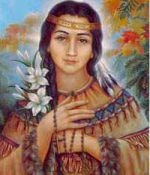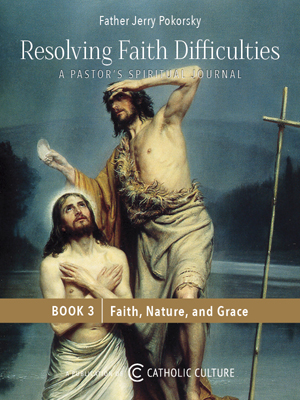The Church’s Mark of Catholicity, on the Surface and in its Depth
By Dr. Jeff Mirus ( bio - articles - email ) | Feb 05, 2014
The third of the Church’s marks, as enumerated in her creeds, does not trace back to the life of the Trinity quite as obviously as do unity and holiness, nor even so easily to the life of our Savior Himself. Yet the connections are there. With the help once again of Figuring out the Church, the new study by Aidan Nichols, OP, I will touch on the classic claims and the underlying doctrinal richness of catholicity.
The Catholic Church is remarkably universal in both her origins and her activities. She was not founded by any particular man emphasizing some subset of the Christian message, but by Christ Himself, and her mission extends to the very ends of the earth. This way of emphasizing the mark of catholicity was strongly developed in the face of the particularism of heresy (the word means to choose a part of the whole). Thus the Church of Christ is not at all identified with one particular place or culture as is so often the case with various sects. She is not named after a man (e.g., Lutheranism) or a doctrine (e.g., Presbyterianism) or a place (e.g., Anglicanism); she is called “Catholic”, which means universal.
In Scripture, this can be seen clearly as part of God’s plan of salvation. Flashes of it appear even amid the exclusivity of the Jews under the Old Covenant, with the conviction that in Abraham all nations shall find blessing (Gn 22:18), and also through the words of the universalist prophets (e.g., Isa 25:7, 66:18; Jer 3:17; Hab 2:5). Our Lord Himself stated that “many will come from east and west and sit at table with Abraham, Isaac, and Jacob in the kingdom of heaven” (Mt 8:10-12). On Pentecost, the multitudes miraculously heard the message of Christ, each in his own language (Acts 2:5). In Revelation, St. John recounts this vision:
Then I saw another angel flying in midheaven, with an eternal gospel to proclaim to those who dwell on earth, to every nation and tribe and tongue and people; and he said with a loud voice, “Fear God and give him glory, for the hour of his judgment has come; and worship him who made heaven and earth, the sea and the fountains of water.” [Rev 14:6-7]
And then, of course, there is the Great Commission in which Christ enjoined his followers to make disciples of all nations (Mk 16:16; Lk 24:47). This extensivity—a sort of quantitative catholicity—was recognized as a special mark of the Church at least as early as the second century, in the letters of St. Ignatius of Antioch.
But key qualitative points were recognized as well, and began to be enumerated as early as the fourth century, in the work of St. Cyril of Jerusalem. Thus the Church possesses all the doctrines necessary for salvation; her mission incorporates every possible kind of person; her graces and sacramental system offer the cure for all sin; and she exhibits in her members every conceivable virtue. Qualitative catholicity pertains to the Church’s possession of key features in a totally integral manner, with the greatest possible amplitude and fullness.
Theological Underpinnings
If we explore the nature of the Church more deeply—particularly with fresh insights articulated in the last century—what we find is that the Church possesses the same kind of unified differentiation or unified diversity which is characteristic of both the Trinity and Incarnate Christ. The Father, Son and Holy Spirit are differentiated in perfect unity—the agent of unity between the Father and the Son being the Holy Spirit. Also, through the overshadowing of the Holy Spirit, Mary conceived the one Christ differentiated into His divine human natures. In the same way, the one Church enjoys a single identity while exhibiting the maximum possible diversity in her members. Indeed, it is through the agency of the Holy Spirit that the vast differentiated membership of the Church, drawn from every time and place, is melded into the one Body of Christ. Unity is of course a mark in its own right; but the immense diversity within that unity is, in effect, the Church’s catholicity.
Indeed, the universal Church boasts not only a wonderful catholicity of individual members, but a remarkable catholicity of local churches. It is only in churches located in time and space that the Eucharist is confected and received to create the one body, yet it is the unremitting mission of the universal Church to facilitate the creation and success of innumerable local churches which together exhibit this wonderful catholicity. In the same way, the Church can be said to possess a catholicity of cultures, for each human culture receives the divine life through the sacraments of the Church while retaining its own distinctive genius—a vast variety of legitimate inculturated expressions of faith forming the Catholic whole.
Again, we can view catholicity as the other side of unity. Drawing on the theological work of the late Cardinal Avery Dulles, Fr. Nichols offers even more along the same lines, presenting a fullness which will serve as a fitting conclusion to my own exploration of this third mark of the Church:
Our grasp of the catholicity of Jesus Christ should be amplified when we consider how he is not just in his divine nature the source of creation and in his human nature a complex example of it. He is also the Head of all creation: the One in whom, as preexistent, the world was made and by whom, as now humanized, the world is to be saved, that is, brought to a new pitch of operation. The Christ descends in his Incarnation and ascends as the glorified risen Lord with the end that he might “fill all things” (Eph 4:10). This process is not yet complete, but it is anticipated in the sacramental economy of the Church. Only at the Parousia (to which the Church’s Liturgy looks forward with expectation and longing), when Christ hands over the finished creation to the Father (cf. 1 Cor 15:28), will the universe be totally penetrated by the catholicity of God. [pp. 62-63]
Previous in series: The Church’s Mark of Holiness, Noted by Friends and Foes
Next in series: The Church’s Mark of Apostolicity, the Preservation of All the Rest
All comments are moderated. To lighten our editing burden, only current donors are allowed to Sound Off. If you are a current donor, log in to see the comment form; otherwise please support our work, and Sound Off!
-
Posted by: John J Plick -
Feb. 06, 2014 3:04 PM ET USA
All of this becomes nothing less than esoteric speculation so far as the witness of the Church militant goes when the Church militant and Her individual members refuse to believe and step out in faith. So much "glory" is given to Church teaching, whereas "Church living" is generally minimized, except to the extent that it can be safely encased in plaster. The Catholic Church should be the hingepoint of renewal in this staggering American society today...., but where is it?!








